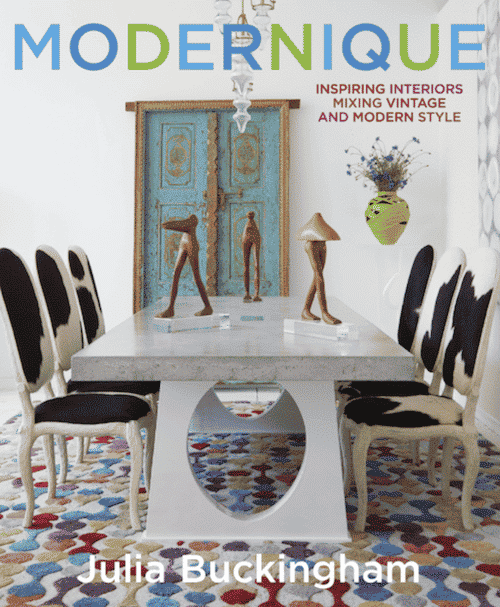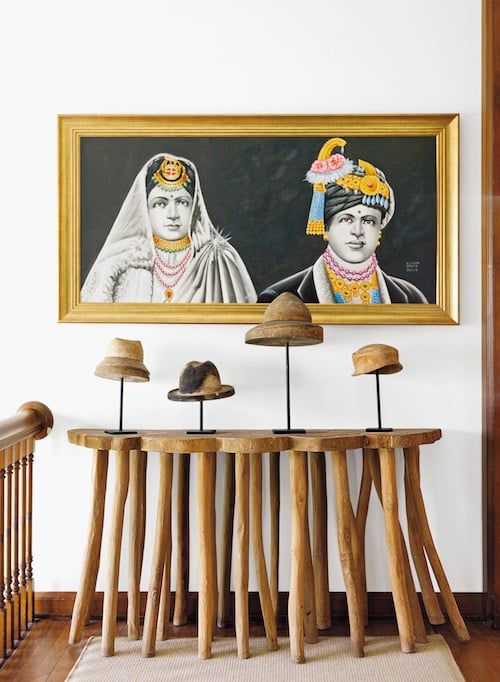
“On our upstairs landing, fashion references play happily with antiques and organic elements,” Julia Buckingham writes of her Chicago home in Modernique. “A massive gilded frame gives this contemporary canvas greater significance.” Photo by Eric Hausman
With roots in fashion and antiques, interior designer Julia Buckingham, of the Chicago firm Buckingham Interiors + Design, defines her style as “modernique.” Through this trademarked blend of modern and vintage, she boldly mixes styles, periods, color, patterns, textures and some bling. Recently released and taking the same name, her debut book, Modernique (Abrams) invites readers to take risks and have fun doing it.
The Study sat down with Buckingham in her winter home in Phoenix to talk about the book and the blend, and how to bring this distinctive eclecticism into our own homes.
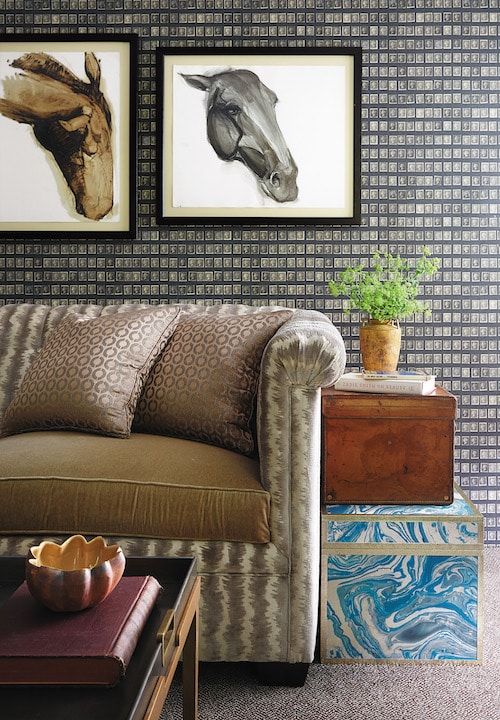
“I love wallpaper patterns that trick the eye — like this one, of vintage postage stamps,” Buckingham writes in her book. Photo by Werner Straube
Why should someone mix modern and vintage?
I started in the fashion industry. I worked for Neiman Marcus and evolved into an antiques dealer. My business partner and I traveled all over the world, and we were able to acquire unusual, interesting artifacts at great prices. So when you’ve got these bits and pieces and if you’re investing in a fantastic sofa or you love modern art, you have a mix of high and low, which allows you to create a unique space that nobody else has. This is a very important part of modernique: living a way that feels right for you.
How does one set out to become a modernique maven?
You start with what you love. The concept of modernique is to acquire over time. We all say “collect,” but that doesn’t mean finding antiques, necessarily. It could be your grandmother’s dresser set. So you start with those anchor pieces, and then you consider scale and how you can put them all together.
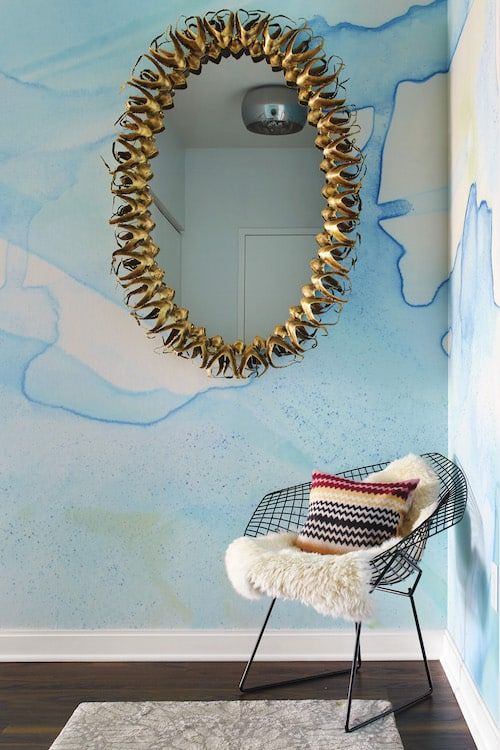
“This apartment’s magnificent view of Lake Michigan inspired the custom water-patterned wallpaper,” Buckingham notes of this space. “With the look of an underwater creature, a vintage brutalist mirror feels right at home.” Photo by Werner Straube
With all these different layers how do you create that “unexpected serenity” mentioned in the book?
I try not to fill the spaces with two many pieces. I have a very dear client whom I’ve worked with for years. She and her husband cannot stop acquiring art. It’s at an addiction level. I went to her home, and she had a piece on every single wall. I said to her, “We need to curate this collection — you’re not even seeing these pieces of art because there is no negative space to enhance your vision and appreciation for these pieces.” She said, “I never thought about it. I just liked them so much, I filled every wall I could.”
So a couple of weeks later, I brought my installer over, and we took her collection and made groupings of it. One of my design assistants went there to drop something off, and she said it doesn’t even look like the same art. That is what’s so important — that you make sure you are not just filling everything, and that you are appreciating that negative space. I definitely like drama and pop, but not too much of it. It’s about knowing when to stop.
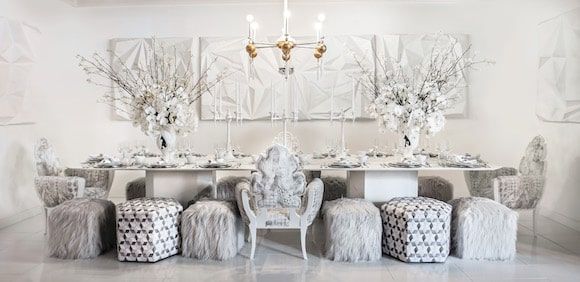
Photo by Alan Barry
Let’s look at some specific examples. Tell us about the all-white space shown above.
Last year, Benjamin Moore asked me to do their Dining by Design DIFFA [Design Industries Foundation Fighting AIDS] table. Their color of the year was Simply White. I came in gangbusters for our first virtual meeting showing them my color board and ideas — and it was like crickets, no sound whatsoever. Then the VP of marketing says, “Julia, we want this to be all white.” And I’m thinking, Why did you ask me, the queen of color? But I think that’s one of the most beautiful spaces I’ve ever put together.
My approach was to create attention in a different way. Cosentino, a large Spanish company that makes Silestone countertops, was the copartner. First, I designed the modern, multi-veined table. Then I started with textures. I needed to have white walls, of course, so I created white art that was multidimensional. The light fixture is a vintage piece made by a fantastic artisan in North Carolina. The centerpieces, the big vases that look like antlers, are one of my products for Global Views. The table settings, donated via Bloomingdales, are more modern. The chairs with the kind of fig-leaf backs are another one of my Global Views developments, and we lacquered them white and added that monochromatic fabric from Pierre Frey. And then you always have to add a little fur. Those fantastic ottomans from Phillips Collection are made out of seat belts.
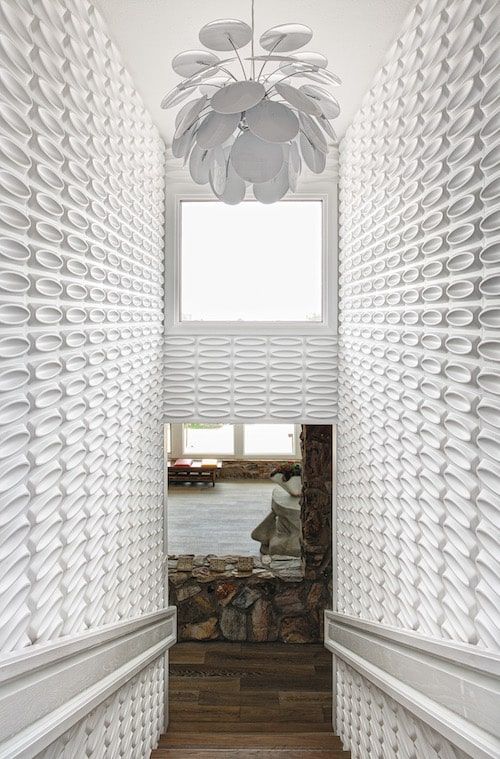
Photo by Eric Hausman
Let’s look at this sci-fi-esque white stairwell.
That is actually our mid-century home in Phoenix. The staircase is short, and there is not a lot going on. I found these crazy wall tiles, which are actually made out of linseed. I showed my tile installer and he was like, “I am not touching that stuff.” I finally found someone to install it. It took them almost two weeks, everything had to be cut perfectly because there is no grout. I wanted to create that whole moment when you walk down the stairs and feel like you’re in a different place.
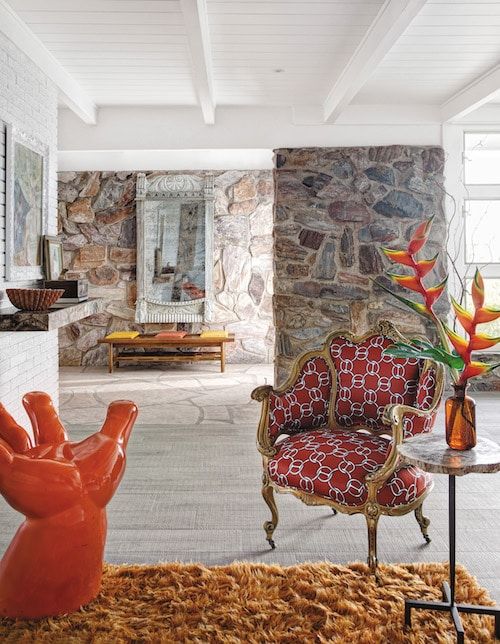
Photo by Eric Hausman
Let’s go down into the room below the stairwell.
I found the hand chair in some crazy antique market in Chicago. I call it the high-five chair. And it kind of high-fives your booty. It is definitely mid-century, and it’s across from a 200-plus-year-old French bergère chair that I upholstered in Hermès fabric. The mirror is probably over 250 years old. It’s Peruvian, and it’s very intricately hand carved. Underneath is a bench from the ‘60s. I kept the original fabric on those cushions — it’s like Naugahyde, but it works with that bench.
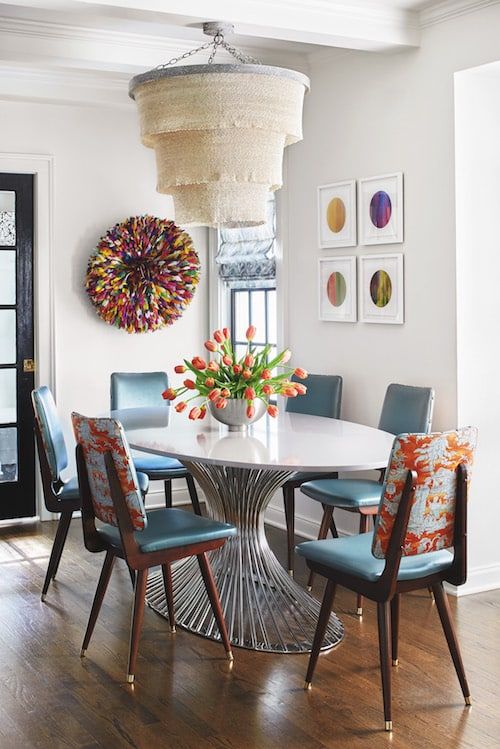
Photo by Werner Straube
Tell us about this space with the chandelier that looks like an upside-down cake and the multicolored art piece.
This is the breakfast room in the Chicago home of one of the most fun clients. This is a very tiny nook, so we had to do a custom table. The tabletop is made out of Silestone, which is indestructible. We affixed the top to a contemporary table base. On the wall is a Juju African headdress made from feathers. I had never seen a multicolored one like that. It’s textural and three-dimensional. And the art that’s on the other wall, that’s by a favorite Chicago artist of mine, Maggie Meiners. The light fixture had to be a little more natural and bespoke-looking, because everything else is so colorful. It’s made of tiny coco beads, so it feels really light.
What is your best piece of advice for how to do this modern and vintage blend?
I know this sounds dramatic, but don’t be afraid. Collect what you love — adding pieces that you feel are disparate can create the most beautiful dichotomy. And start a collection, not necessarily with any final goal in mind, but with abandon. If you look around, you might start to see that you’re attracted to inkwells, or black-and-white photography or postcards. Those elements can be a wonderful addition to your home when you get to the point when you decide what you want to do with them.
Purchase This Book
(or support your local bookstore)
